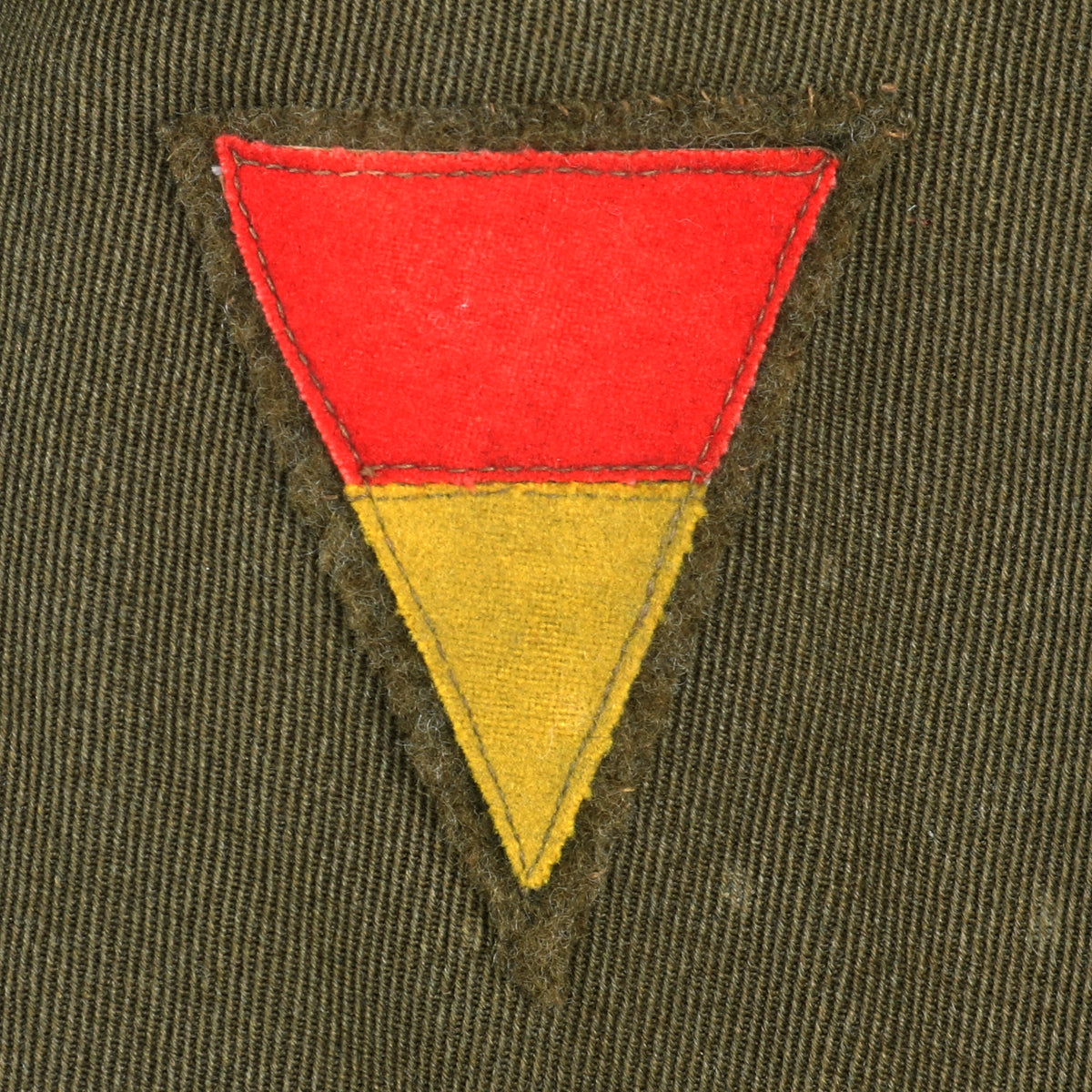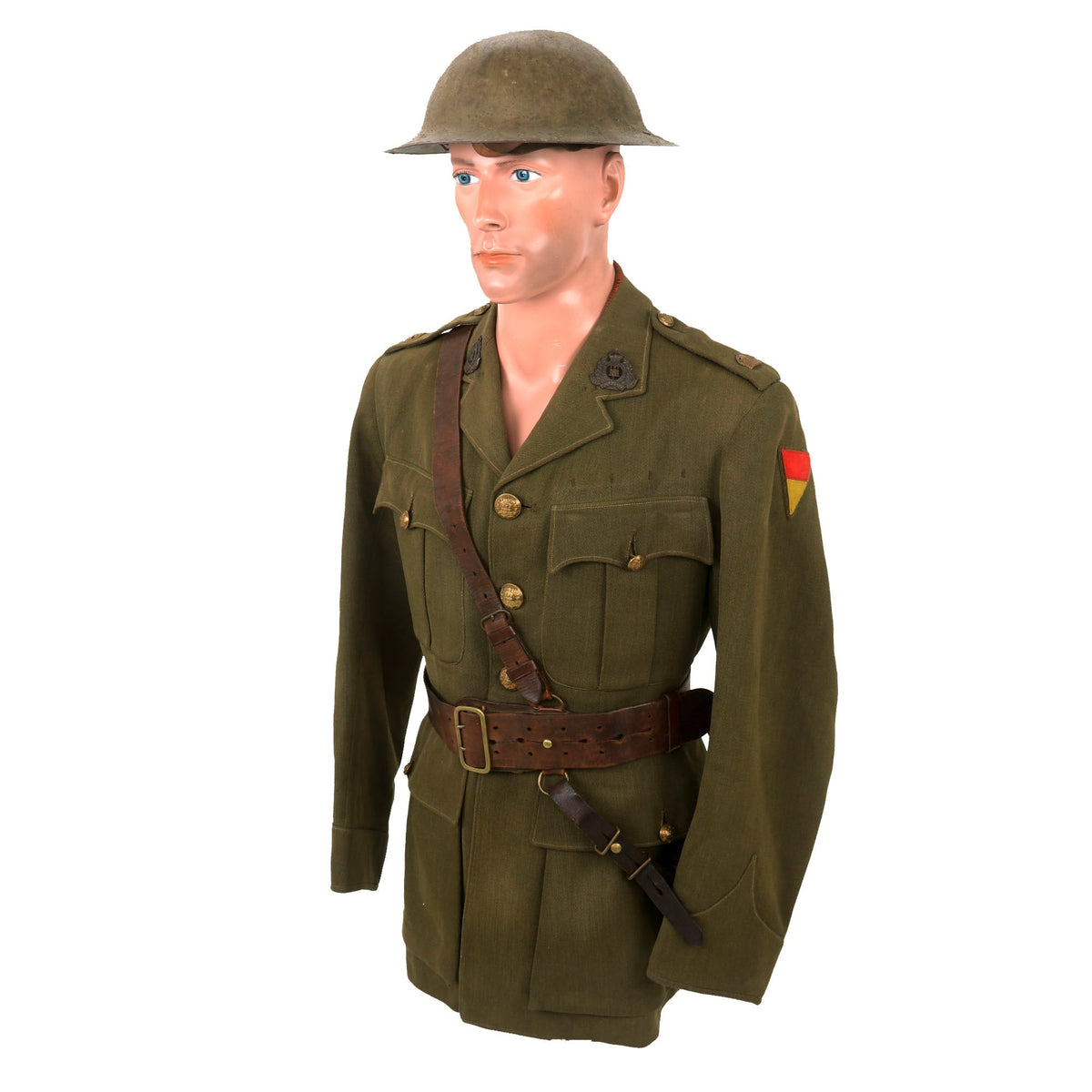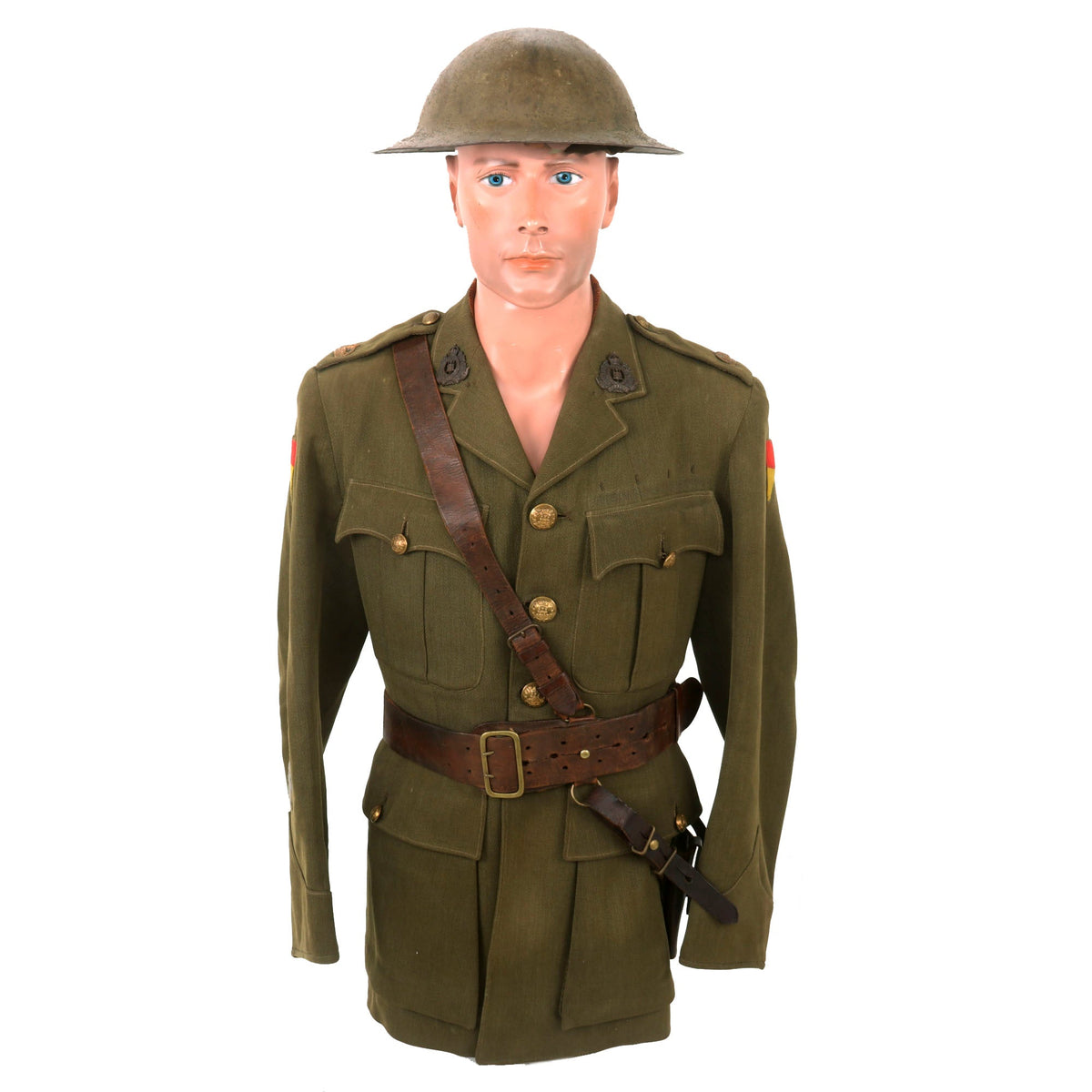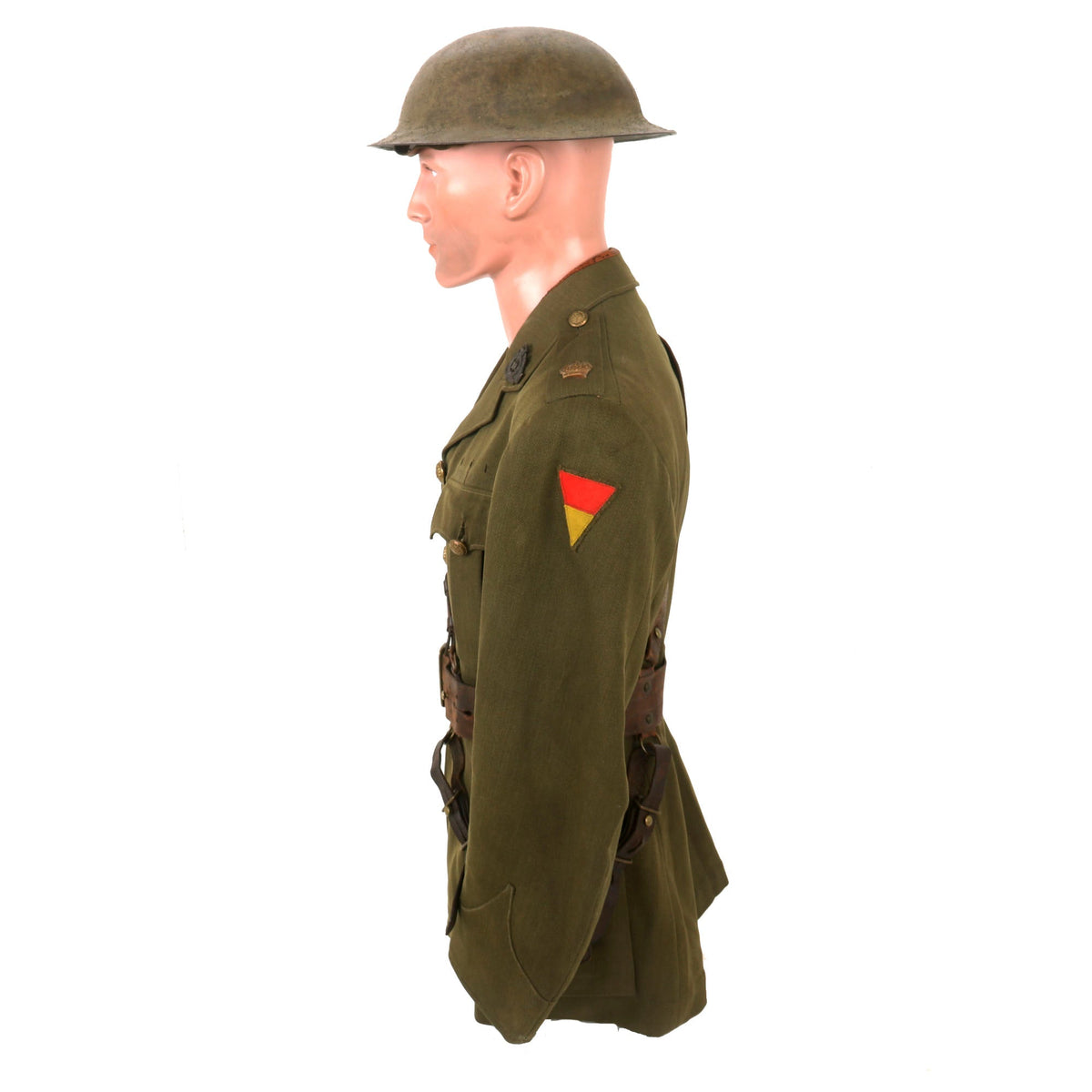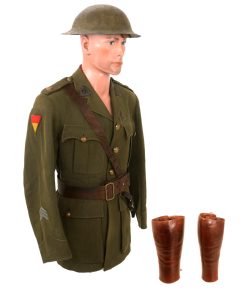Original British WWI Named 8th Suffolk Regiment Major’s Uniform with Tactical Flashes, Brodie Helmet, Sam Brown Belt Rig & Gaiters Original Items
$ 1.395,00 $ 348,75
Original Item: Only One Available: This is a phenomenal British officer’s uniform with period-applied tactical flashes! One of the most iconic uniforms of the First World War is that of the British officer, designed with an open collar to distinguish them on the battlefield.
This is a World War I British 1916 Pattern Officer’s uniform named to a Major in the Suffolk Regiment. The tunic has tactical flashes for the Suffolk Regiment on each shoulder, three service chevrons on the right cuff, denoting three years overseas. Major rank insignia (a single crown) on each shoulder, and Suffolk regiment buttons. There is a tag in the pocket reading:
“Divisionally marked to: The 18th (Eastern) Division (New Army) (8th Suffolk) Name + Date too faint to read.”
We believe the tactical flashes on this uniform to be for the 8th Suffolk Service Battalion, as traditional Suffolk flashes are red & yellow rectangles as opposed to the red & yellow triangle on this uniform.
The jacket is very well worn, with the leather collar lining being very worn. One of the shoulder boards is partially ripped on one end. There is very little mothing on the uniform, otherwise showing heavy wear in the field. His Suffolk Regiment cap badge was in the pocket, a very nice detail!
Also included is his officer’s Sam Brown belt with an attached sword hanger , his British Brodie helmet with a full liner and chinstrap, and his officer’s leather gaiters. The helmet is in good worn shape, and displays very beautifully with the helmet.
You likely won’t see another tunic like this one for sale stateside anytime soon. Don’t miss out on this iconic piece of World War I history.
Comes ready for further research. The name on the tag can be discerned with enough work, and a list of Majors in the regiment may be obtainable.
The 8th Battalion, Suffolk Regiment, all of whom were volunteers, landed in France on July 25th, 1915 and were moved to the Albert sector. In 1916 the Battalion participated in the First Battle of the Somme, Longueval, Delville Wood, and Thiepval.
The Suffolk Regiment
The origins of the Suffolk Regiment can be traced to 1685 when Henry, 7th Duke of Norfolk, raised a regiment in Norfolk and Suffolk as part of the forces of James II to meet the threat of the Monmouth Rebellion. The regiment was known in its early years by the names of the various colonels who commanded it.
After a few weeks in East Anglia, the regiment was moved to Windsor Castle and thence to Ireland where it was engaged in many actions including the Battle of the Boyne. In the next forty-five years it saw service in Flanders, the West Indies and the Balearic Islands, returning to Suffolk in 1730.
In 1742 the regiment left for Europe to take part in the War of the Austrian Succession (1740-1748). It was present at the Battle of Dettingen on 27 June 1743 against the French, the last battle in which an English monarch led his troops in the field. The A djutant at that time was James Wolfe, later to gain fame as General Wolfe of Canada.
In 1751 Infantry Regiments were numbered and no longer took the name of their commanding officer. The regiment became the XIIth Foot, thus indicating its seniority as one of the oldest regiments in the army.
During the Seven Years War (1756-1763), at the Battle of Minden, on 1 August 1759, six British Regiments of Foot, including the XIIth, defeated ten thousand French cavalry. As the British Infantry advanced through some gardens they picked roses and wore them in their hats; after that on every ‘Minden Day’ members of the Suffolk Regiment wore red and yellow roses to commemorate the victory.
1769 saw the regiment sail for Gibraltar, where it spent the next fourteen years. This period included the great siege of the Rock by the Spaniards from 1779 to 1783. 1781 saw a further change in the title: in addition to XIIth Foot, it was also to be known as The East Suffolk Regiment. The years between 1783 and 1796 saw the regiment in widely scattered places: England, Ireland, the Channel Islands, Barbados, Martinique and Flanders.
In 1796 the regiment paid the first of many visits to India, remaining there for the next ten years in operations against the French and local rulers. In 1810 it took part in the capture of the island of Mauritius, and remained there on garrison duty until 1818. After the Napoleonic Wars there followed a long period of comparative peace with the regiment serving in various parts of the world.
In 1842 a Reserve Battalion was formed which took part in the ‘Kaffir Wars’ in South Africa (1851-1853) and it was a draft to reinforce this battalion which was on the troop ship “Birkenhead” when it was wrecked on 24 February 1852 with the loss of most of the troops.
In 1854 the regiment sailed for Australia and remained there, and in Tasmania, until 1860 when it went to New Zealand to help put down the Maori Rebellion. It was during this period that alliances with the Launceston Regiment of Australia and the Auckland Regiment of New Zealand were formed. In 1858 the Reserve Battalion became the 2nd Battalion.
The 2nd Battalion sailed for India in 1864 and from then until 1907 one or other battalion was usually serving there. The 1st Battalion had returned to England in 1867 and in 1878 the Depot was built at Gibraltar Barracks, Bury St Edmunds. In 1881 the regiment became The Suffolk Regiment. At the time of the Boer War (1899-1902) approximately 90% of the strength of the 1st Battalion, who took part in the conflict, were Suffolk men.
The new century saw the further involvement of the citizens of Suffolk in the County Regiment with the formation of the Territorial Army in 1908. The 4th Battalion, The Suffolk Regiment (TA.) had its Headquarters in Ipswich and Drill Halls throughout East Suffolk, whilst the 5th Battalion The Suffolk Regiment (T.A.) was based on Bury St Edmunds and covered West Suffolk.
The 1914-1918 War saw the raising of twenty-five battalions of the Suffolk Regiment. The Regular Army formed the British Expeditionary Force to France in 1914, which included the 2nd Battalion. The Regular Army was virtually destroyed following the Battles of Mons and The Marne and to replace it Kitchener’s New Army was formed. These new units – the 7th, 8th, 9th, 11th and 12th Battalions – followed the Regulars into the war: six battalions of the regiment were engaged on the Somme in 1916 and five in the battles at Arras in 1917. During the war years, apart from France and Flanders, battalions of the regiment fought at Gallipoli, Salonika and in the Middle East. The Regimental Chapel situated in St Mary’s Church, Bury St Edmunds, commemorates the 360 officers and 6,513 other ranks of the Suffolk Regiment who did not return.
The 18th (Eastern) Division
The 18th (Eastern) Division was an infantry division of the British Army formed in September 1914 during the First World War as part of the K2 Army Group, part of Lord Kitchener’s New Armies. From its creation the division trained in England until 25 May 1915 when it landed in France and spent the duration of the First World War in action on the Western Front, becoming one of the elite divisions of the British Army. During the Battle of the Somme in the latter half of 1916, the 18th Division was commanded by Major General Ivor Maxse.
Fast Shipping with Professional Packaging
Thanks to our longstanding association with UPS FedEx DHL, and other major international carriers, we are able to provide a range of shipping options. Our warehouse staff is expertly trained and will wrap your products according to our exact and precise specifications. Prior to shipping, your goods will be thoroughly examined and securely secured. We ship to thousands clients each day across multiple countries. This shows how we're dedicated to be the largest retailer on the internet. Warehouses and distribution centres can be located throughout Europe as well as the USA.
Note: Orders with more than one item will be assigned a processing date depending on the item.
Before shipping before shipping, we'll conduct a thorough inspection of the items you have ordered. Today, the majority of orders will be delivered within 48 hours. The delivery time will be between 3-7 days.
Returns
The stock is dynamic and we cannot completely manage it because multiple stakeholders are involved, including our factory and warehouse. So the actual stock may alter at any time. It's possible that you may not receive your order once the order has been made.
Our policy is valid for a period of 30 days. If you don't receive the product within 30 days, we are not able to issue a refund or an exchange.
You can only return an item if it is unused and in the same state as the day you received it. You must have the item in its original packaging.
Related products
Uncategorized
Uncategorized
Uncategorized
Armored Burgonet Helmet & Polearm from Scottish Castle Leith Hall Circa 1700 Original Items
Uncategorized
Angolan Rebel 1970s era 60mm Inert Display Mortar from Angolan Civil War Original Items
Uncategorized
Uncategorized
Band of Brothers ORIGINAL GERMAN WWII Le. F.H. 18 10.5cm ARTILLERY PIECE Original Items
Uncategorized
Uncategorized
Uncategorized
Uncategorized
Uncategorized
Uncategorized
Uncategorized
Uncategorized
Uncategorized
Uncategorized
Uncategorized
Uncategorized
Uncategorized

